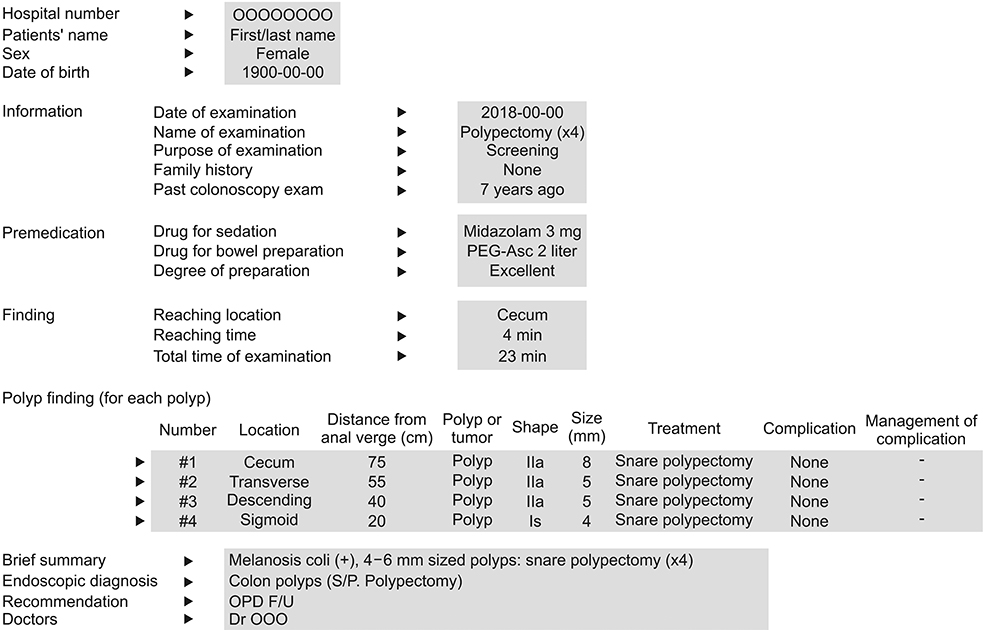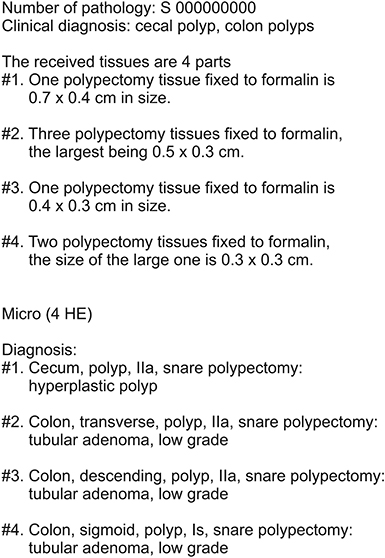Ann Surg Treat Res.
2019 Dec;97(6):319-325. 10.4174/astr.2019.97.6.319.
Validation of an automated adenoma detection rate calculating system for quality improvement of colonoscopy
- Affiliations
-
- 1Center for Colorectal Cancer, Research Institute and Hospital, National Cancer Center, Goyang, Korea. gsgsbal@ncc.re.kr
- 2Information Technology Team, Research Institute and Hospital, National Cancer Center, Goyang, Korea.
- 3Endoscopy Room, Research Institute and Hospital, National Cancer Center, Goyang, Korea.
- KMID: 2464788
- DOI: http://doi.org/10.4174/astr.2019.97.6.319
Abstract
- PURPOSE
This study aimed to validate an automated calculating system developed for determining the adenoma detection rate (ADR).
METHODS
To calculate the automated ADR, the data linking processes were as follows: (1) matching the selected colonoscopy results with the pathological results, (2) matching the polyp number from colonoscopy with that from pathology and confirming the histopathological results of each colonic polyp, and (3) confirming the histopathological results, especially the adenoma status of each colonic polyp. To verify the accuracy of the automated ADR calculating system, we manually calculated the ADR for 3 months through medical record review. Accuracy was calculated by measuring the error rate for each value. The cause of error was analyzed by additional order and chart review.
RESULTS
After excluding 318 cases, 2,543 patients (1,351 men and 1,192 women; median age, 57.9 years) who underwent colonoscopy were included in this study. When the automated calculating system was used, polyps were found in 1,336 cases (52.6%) and adenomas were found in 1,003 cases (39.4%). When the manual calculating system was used, polyps were found in 1,327 cases (52.2%) and adenomas were found in 1,003 cases (39.4%). The accuracies of the polyp detection rate and ADR according to the automated calculating system were 99.3% and 100%, respectively.
CONCLUSION
We developed a system to automatically calculate the ADR by extracting hospital electronic medical record results and verified that it provided satisfactory results. It may help to improve colonoscopy quality.
MeSH Terms
Figure
Reference
-
1. Jung KW, Won YJ, Kong HJ, Lee ES. Community of Population-Based Regional Cancer Registries. Cancer statistics in Korea: incidence, mortality, survival, and prevalence in 2015. Cancer Res Treat. 2018; 50:303–316.2. Levin B, Lieberman DA, McFarland B, Smith RA, Brooks D, Andrews KS, et al. Screening and surveillance for the early detection of colorectal cancer and adenomatous polyps, 2008: a joint guideline from the American Cancer Society, the US Multi-Society Task Force on Colorectal Cancer, and the American College of Radiology. CA Cancer J Clin. 2008; 58:130–160.3. Sohn DK, Kim MJ, Park Y, Suh M, Shin A, Lee HY, et al. The Korean guideline for colorectal cancer screening. J Korean Med Assoc. 2015; 58:420–432.4. Kahi CJ, Imperiale TF, Juliar BE, Rex DK. Effect of screening colonoscopy on colorectal cancer incidence and mortality. Clin Gastroenterol Hepatol. 2009; 7:770–775.5. Winawer SJ, Zauber AG, Ho MN, O'Brien MJ, Gottlieb LS, Sternberg SS, et al. Prevention of colorectal cancer by colonoscopic polypectomy. The National Polyp Study Workgroup. N Engl J Med. 1993; 329:1977–1981.6. Zauber AG, Winawer SJ, O'Brien MJ, Lansdorp-Vogelaar I, van Ballegooijen M, Hankey BF, et al. Colonoscopic polypectomy and long-term prevention of colorectal-cancer deaths. N Engl J Med. 2012; 366:687–696.7. Kaminski MF, Regula J, Kraszewska E, Polkowski M, Wojciechowska U, Didkowska J, et al. Quality indicators for colonoscopy and the risk of interval cancer. N Engl J Med. 2010; 362:1795–1803.8. Kaminski MF, Wieszczy P, Rupinski M, Wojciechowska U, Didkowska J, Kraszewska E, et al. Increased rate of adenoma detection associates with reduced risk of colorectal cancer and death. Gastroenterology. 2017; 153:98–105.9. Samadder NJ, Curtin K, Tuohy TM, Pappas L, Boucher K, Provenzale D, et al. Characteristics of missed or interval colorectal cancer and patient survival: a population-based study. Gastroenterology. 2014; 146:950–960.10. Deutsch JC. Colonoscopy quality, quality measures, and a natural language processing tool for electronic health records. Gastrointest Endosc. 2012; 75:1240–1242.11. Lee TJ, Rutter MD, Blanks RG, Moss SM, Goddard AF, Chilton A, et al. Colonoscopy quality measures: experience from the NHS Bowel Cancer Screening Programme. Gut. 2012; 61:1050–1057.12. Corley DA, Jensen CD, Marks AR, Zhao WK, Lee JK, Doubeni CA, et al. Adenoma detection rate and risk of colorectal cancer and death. N Engl J Med. 2014; 370:1298–1306.13. Yun JH, Ahn SJ, Kim Y. Development of clinical contents model markup language for electronic health records. Healthc Inform Res. 2012; 18:171–177.14. de Lusignan S. Informatics as tool for quality improvement: rapid implementation of guidance for the management of chronic kidney disease in England as an exemplar. Healthc Inform Res. 2013; 19:9–15.15. Imler TD, Morea J, Kahi C, Imperiale TF. Natural language processing accurately categorizes findings from colonoscopy and pathology reports. Clin Gastroenterol Hepatol. 2013; 11:689–694.16. Imler TD, Morea J, Kahi C, Sherer EA, Cardwell J, Johnson CS, et al. Multi-center colonoscopy quality measurement utilizing natural language processing. Am J Gastroenterol. 2015; 110:543–552.17. Raju GS, Lum PJ, Slack RS, Thirumurthi S, Lynch PM, Miller E, et al. Natural language processing as an alternative to manual reporting of colonoscopy quality metrics. Gastrointest Endosc. 2015; 82:512–519.18. Nayor J, Borges LF, Goryachev S, Gainer VS, Saltzman JR. Natural language processing accurately calculates adenoma and sessile serrated polyp detection rates. Dig Dis Sci. 2018; 63:1794–1800.19. Lieberman DA, Rex DK, Winawer SJ, Giardiello FM, Johnson DA, Levin TR. Guidelines for colonoscopy surveillance after screening and polypectomy: a consensus update by the US Multi-Society Task Force on Colorectal Cancer. Gastroenterology. 2012; 143:844–857.20. Francis DL, Rodriguez-Correa DT, Buchner A, Harewood GC, Wallace M. Application of a conversion factor to estimate the adenoma detection rate from the polyp detection rate. Gastrointest Endosc. 2011; 73:493–497.21. Kim JH, Choi YJ, Kwon HJ, Park SJ, Park MI, Moon W, et al. Simple colonoscopy reporting system checking the detection rate of colon polyps. World J Gastroenterol. 2015; 21:9380–9386.22. Oh JR, Han KS, Hong CW, Kim BC, Kim B, Park SC, et al. Colonoscopy learning curves for colorectal surgery fellow trainees: experiences with the 15-year colonoscopy training program. Ann Surg Treat Res. 2018; 95:169–174.23. Lin OS, Kozarek RA, Arai A, Gluck M, Jiranek GC, Kowdley KV, et al. The effect of periodic monitoring and feedback on screening colonoscopy withdrawal times, polyp detection rates, and patient satisfaction scores. Gastrointest Endosc. 2010; 71:1253–1259.
- Full Text Links
- Actions
-
Cited
- CITED
-
- Close
- Share
- Similar articles
-
- Quality indicators in colonoscopy: the chasm between ideal and reality
- The Miss Rate for Colorectal Adenoma Determined by Quality-Adjusted, Back-to-Back Colonoscopies
- New Colonoscopy Devices to Improve Colon Neoplasm Detection
- Limitation and Value of Using the Adenoma Detection Rate for Colonoscopy Quality Assurance
- Correlation Between Bowel Preparation and the Adenoma Detection Rate in Screening Colonoscopy



